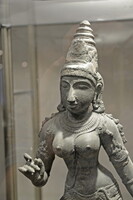| dc.coverage.spatial | Site: Government Museum and National Art Gallery (Chennai, Tamil Nādu, India) Acc.No. 462/61 | en_US |
| dc.coverage.temporal | ca. 13th century (creation) | en_US |
| dc.creator | unknown (Indian (South Asian)) | en_US |
| dc.date | 1200-1299 | en_US |
| dc.date.accessioned | 2016-08-23T18:13:58Z | |
| dc.date.available | 2016-08-23T18:13:58Z | |
| dc.date.issued | 1200-1299 | en_US |
| dc.identifier | 268024 | en_US |
| dc.identifier.other | archrefid: 3365 | en_US |
| dc.identifier.uri | http://hdl.handle.net/1721.3/184338 | |
| dc.description | Detail, head and torso; Parvati is the wife consort of the Hindu deity Shiva. Here, Parvati is identified by her conical crown with mountainlike (karandamukuta) tiers. At the back is the siraschakra, also called prabhamandala, a type of halo. She stands in a triple-bend (tribhanga) pose with a pronounced sway and holds one arm and hand down in a dramatic fashion. The other hand is posed in a manner that represents holding a flower. Images of Parvati in this position often accompany Shiva in his role as Lord of Dance (Nataraja), suggesting that this sculpture once may have been placed to the left of an image of the god. She wears luxurious jewelry and a diaphanous skirt secured with a heavy belt, both of which emphasize her sensual volumes. From Pudukkudi, Undivided Thanjavur District. Source: Metropolitan Museum of Art [website]; http://www.metmuseum.org (accessed 5/13/2015) | en_US |
| dc.format.medium | bronze | en_US |
| dc.rights | © Scott Gilchrist, Archivision, Inc. | en_US |
| dc.subject | deities | en_US |
| dc.subject | Hinduism | en_US |
| dc.subject | Saivism | en_US |
| dc.subject | Chola | en_US |
| dc.title | Parvati | en_US |
| dc.title.alternative | Standing Parvati | en_US |
| dc.type | image | en_US |
| dc.rights.access | Licensed for educational and research use by the MIT community only | en_US |
| dc.identifier.vendorcode | 7A2-IN-GMC-PAR-A02 | en_US |
| vra.culturalContext | Indian (South Asian) | en_US |
| vra.technique | casting (process) | en_US |
| vra.worktype | sculpture (visual work) | en_US |
| dc.contributor.display | unknown (Indian) | en_US |

